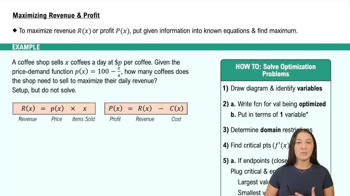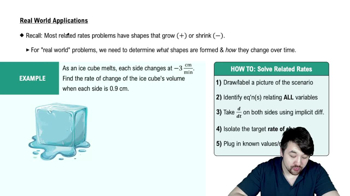Table of contents
- 0. Functions7h 52m
- Introduction to Functions16m
- Piecewise Functions10m
- Properties of Functions9m
- Common Functions1h 8m
- Transformations5m
- Combining Functions27m
- Exponent rules32m
- Exponential Functions28m
- Logarithmic Functions24m
- Properties of Logarithms34m
- Exponential & Logarithmic Equations35m
- Introduction to Trigonometric Functions38m
- Graphs of Trigonometric Functions44m
- Trigonometric Identities47m
- Inverse Trigonometric Functions48m
- 1. Limits and Continuity2h 2m
- 2. Intro to Derivatives1h 33m
- 3. Techniques of Differentiation3h 18m
- 4. Applications of Derivatives2h 38m
- 5. Graphical Applications of Derivatives6h 2m
- 6. Derivatives of Inverse, Exponential, & Logarithmic Functions2h 37m
- 7. Antiderivatives & Indefinite Integrals1h 26m
- 8. Definite Integrals4h 44m
- 9. Graphical Applications of Integrals2h 27m
- 10. Physics Applications of Integrals 2h 22m
4. Applications of Derivatives
Related Rates
Problem 33c
Textbook Question
Based on sales data over the past year, the owner of a DVD store devises the demand function D(p) = 40 - 2p, where D(p) is the number of DVDs that can be sold in one day at a price of p dollars.
Find the elasticity function for this demand function.
 Verified step by step guidance
Verified step by step guidance1
Step 1: Understand the concept of elasticity. Elasticity of demand measures how the quantity demanded of a good responds to a change in price. It is defined as E(p) = - (p / D(p)) * (dD/dp), where D(p) is the demand function and dD/dp is its derivative.
Step 2: Identify the given demand function. The demand function provided is D(p) = 40 - 2p.
Step 3: Differentiate the demand function with respect to p. Find dD/dp by differentiating D(p) = 40 - 2p. The derivative, dD/dp, is the rate of change of demand with respect to price.
Step 4: Substitute D(p) and dD/dp into the elasticity formula. Use the formula E(p) = - (p / D(p)) * (dD/dp) and substitute the expressions for D(p) and dD/dp.
Step 5: Simplify the expression for E(p). Simplify the expression obtained in Step 4 to get the elasticity function in terms of p.
 Verified video answer for a similar problem:
Verified video answer for a similar problem:This video solution was recommended by our tutors as helpful for the problem above
Video duration:
3mPlay a video:
Was this helpful?
Key Concepts
Here are the essential concepts you must grasp in order to answer the question correctly.
Demand Function
A demand function expresses the relationship between the price of a good and the quantity demanded by consumers. In this case, D(p) = 40 - 2p indicates that as the price (p) increases, the quantity of DVDs sold (D) decreases. Understanding this function is crucial for analyzing how price changes affect consumer behavior.
Recommended video:

Properties of Functions
Elasticity of Demand
Elasticity of demand measures how responsive the quantity demanded is to a change in price. It is calculated as the percentage change in quantity demanded divided by the percentage change in price. This concept helps determine whether demand is elastic (sensitive to price changes) or inelastic (less sensitive), which is essential for pricing strategies.
Recommended video:

Maximizing Profit & Revenue
Calculating Elasticity
To find the elasticity function for the given demand function, we use the formula E(p) = (D'(p) * p) / D(p), where D'(p) is the derivative of the demand function with respect to price. This calculation provides a function that indicates how elasticity varies with price, allowing the store owner to make informed decisions about pricing and inventory.
Recommended video:

Determining Error and Relative Error Example 1
Related Videos
Related Practice






